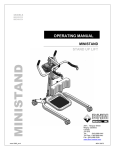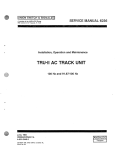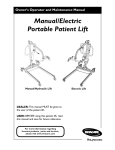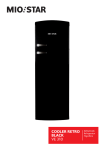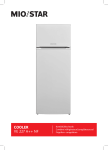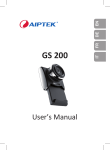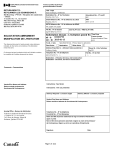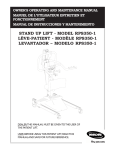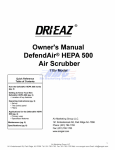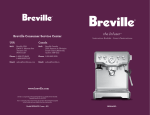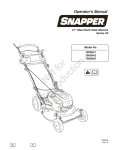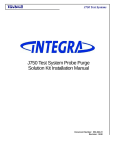Download OPERATING MANUAL
Transcript
MODEL # 82101041 82101043 82101044 OPERATING MANUAL JUNIOR FOLDING LIFT 2001, Tanguay Street Magog (Quebec) Canada J1X 5Y5 Phone: (819) 868-0441 Toll free 1-800-868-0441 Fax: (819) 868-2249 E-mail: www.bhm-medical.com 5155 Spectrum Way, unit 33 Mississauga (Ontario) Canada L4W 5A1 14 Cross St. London, SW13 0PS, United Kingdom Tel: +44 (0)7740 717146 Fax: +44 (0)870 1619681 Jan 2005 (rev 3) #001.23103 2 TABLE OF CONTENTS TABLE OF CONTENTS ............................................................................................................. 3 SYMBOLS .................................................................................................................................. 4 SAFETY INSTRUCTIONS & WARNINGS ................................................................................. 5 GENERAL ............................................................................................................................................... 5 SHOCK PREVENTION .......................................................................................................................... 7 FIRE AND EXPLOSION ........................................................................................................................ 7 EQUIPMENT WARNING LABELS ...................................................................................................... 7 OPERATING THE JUNIOR ........................................................................................................ 8 INTRODUCTION.................................................................................................................................... 8 READ CAREFULLY SAFETY INSTRUCTIONS AND WARNINGS SECTION BEFORE ATTEMPTING TO USE THE LIFT ....................................................................................................... 8 ALWAYS CARRY OUT THE DAILY CHECKLIST BEFORE USING THE LIFT............................ 8 ADJUSTING THE WIDTH OF THE LEGS........................................................................................... 8 CORRECT USE OF THE BRAKES ....................................................................................................... 9 EMERGENCY SHUT-OFF................................................................................................................... 10 BATTERY PACK.................................................................................................................................. 10 CHARGING THE BATTERY............................................................................................................... 11 RAISING AND LOWERING THE PATIENT ..................................................................................... 12 To raise the patient: ................................................................................................................................ 12 To lower the patient: .......................................................................................................................... 12 DAILY VISUAL CHECKLIST............................................................................................................. 13 TRANSFERRING THE PATIENT ....................................................................................................... 13 EMERGENCY LOWERING................................................................................................................. 14 TROUBLESHOOTING GUIDE ................................................................................................. 15 TRANSFER SLING SAFETY ................................................................................................... 16 HOW TO CONDUCT A VISUAL SAFETY INSPECTION................................................................ 17 LAUNDERING INSTRUCTIONS........................................................................................................ 18 VISUAL SAFETY INSPECTION RECORD........................................................................................ 18 MONTHLY INSPECTION DETAILS ......................................................................................... 19 DIAGRAM................................................................................................................................. 20 WARRANTY ............................................................................................................................. 21 WARNING! All rights reserved. CONFIDENTIAL. The reproduction of this document or the transmittal in any form of any information, contained herein, without the authority in writing of an officer of the manufacturer is prohibited. TECHNICAL SPECIFICATIONS AND DESIGN SUBJECT TO CHANGE WITHOUT NOTICE. 3 SYMBOLS WARNING: this symbol is intended to alert the user to hazards or unsafe practices which could result in serious bodily harm. CAUTION: this symbol is intended to alert the user of the presence of important operating and maintenance instructions which could prevent product damage or possible personal injury. NOTE: this symbol offers helpful information concerning certain operating procedures. CONSULT ACCOMPANYING DOCUMENTS BOOM "UP" BOOM "DOWN" BASE "CLOSED" INDICATES CHARGING MODE INDICATES CHARGER POWER IS "ON" BASE "OPENED" DO NOT ATTEMPT TO USE THIS EQUIPMENT WITHOUT UNDERSTANDING THIS MANUAL. To ensure safe operation, read carefully the entire manual, especially the section on Safety Instructions and Warnings , before installing, operating or servicing this equipment. If anything is not completely understood, please contact your supplier for more details. Failure to comply with warnings in this manual may result in injury. Keep this manual with lift and refer to it as required. Contents of this manual are subjected to change without prior notice to users. 4 SAFETY INSTRUCTIONS & WARNINGS GENERAL IMPORTANT CAREFULLY READ THESE INSTRUCTIONS OR SERIOUS INJURY MAY RESULT. READ OPERATING MAINTENANCE INSTRUCTIONS IN THIS MANUAL BEFORE INSTALLING, OPERATING, OR SERVICING THIS EQUIPMENT. ALWAYS KEEP THESE INSTRUCTIONS WITH THE LIFT. YOUR LIFT is for transferring patients only. Do not use the lift for any other purpose. This mobile floor lift is not intended to be a transport device or to be used to transport a patient over any long distance. Do not attempt to manoeuvre the lift by pushing on the mast, motor shaft, boom or patient. DO NOT USE, in any way, the actuator as a handle to push or pull the lift. If the actuator is used as a handle, the caregiver and the patient safety is greatly compromised. ALWAYS manoeuvre the lift with the handles provided. DO NOT attempt to push or pull a loaded lift over a floor obstruction which the casters are unable to ride over easily. ALWAYS carry out the daily checklist before using the lift. IMPORTANT: Keep all components of the lift clean and dry, and have electrical and mechanical safety checkpoints done as instructed in the Daily visual checklist and the Monthly inspection details sections of this manual. Slings and accessories designed by any other manufacturer are prohibited and will void warranty. Use only the specified slings and accessories to maintain patient safety and product utility. DO NOT use a sling that is not recommended for the lift. NEVER use a damaged, torn or frayed sling. ALWAYS place the sling around patient according to the instructions enclosed. FOLLOW lifting procedures outlined in this manual. ALWAYS be prepared before attempting to transfer a patient. This mobile floor lift is intended to be used for patients within the specified weight limit indicated on the lift. Do not attempt to lift more than the weight limit indicated. BEFORE attempting to transfer, the patient must be assessed by a qualified professional. This mobile patient lift must be used by a trained caregiver to work with the patient to be transferred. This patient lift should never be used by a patient on their own. ONLY trained and qualified caregivers should transfer a patient. DO NOT attempt to use the lift if you have not been properly trained to do so. USE all controls and safety features only according to the rules specified in this manual. Never attempt to force a control or button on the lift. Replace any precautionary or instruction labels that cannot be easily read. 5 SAFETY INSTRUCTIONS & WARNINGS DO NOT store the lift in a shower, bath or other area with high humidity. DO NOT use an electric lift in a shower DO NOT push a loaded lift at speeds which exceed a slow walking pace (3 km/hour or 0.8 meter/second). DO NOT push the lift over uneven or rough ground, particularly if loaded. DO NOT BUMP the lift down steps, loaded or unloaded. DO NOT park a loaded lift on any sloping surface. BASE should not be opened as much as possible for optimum safety. Do not put fingers, hands or feet where space is limited (see diagram below). This could pinch, cut or seriously hurts any parts exposed. 6 SAFETY INSTRUCTIONS & WARNINGS SHOCK PREVENTION AVOID violent shock during transportation. DO NOT touch or use a lift with bare conductors or a damaged power cord. Electrically live equipment can electrocute a patient. If the lift or charger has any exposed or damaged wires, contact your local dealer immediately. DO NOT splash or expose electric parts of the device to water or moisture. CHECK nameplate for voltage and cycle requirements. These requirements differ by country. Do not attempt to use the lift in an area that has a different voltage and cycle requirements. READ the battery and charger instructions thoroughly before using or storing them. FIRE AND EXPLOSION Batteries may explode, leak and cause personal injury of not disposed of properly. Do not place or store the battery under direct sunlight or near a heat source. Do not dispose of in fire. Do not short the battery terminals. Do not incinerate. Flush with water if electrolyte (Acid) comes in contact with skin or eyes. Batteries must be recycled or disposed according to local law regulations. When returning batteries, insulate their terminals with adhesive tape, etc., otherwise the residual electricity in used batteries may cause fire or explosion. IMPORTANT : BATTERIES NEED TO BE CHARGED FOR A MINIMUM OF 8 HOURS PRIOR TO USING THIS LIFT FOR THE FIRST TIME. EQUIPMENT WARNING LABELS Inspect all precautionary labels on the equipment. Order and replace all labels that cannot be easily read. 7 OPERATING THE JUNIOR INTRODUCTION READ CAREFULLY SAFETY INSTRUCTIONS AND WARNINGS SECTION BEFORE ATTEMPTING TO USE THE LIFT ALWAYS CARRY OUT THE DAILY CHECKLIST BEFORE USING THE LIFT. Operating the Junior is simple and requires little instruction. Using the lift, an operator is able to raise, transfer, and lower a patient safely. IMPORTANT! The Junior should not be used in conjunction with any patient slings other than the Manufacturer slings which are expressly designed for the system. The manufacturer disclaims any responsibility for improper use employing any other sling. NOTE: Instructions provided here are described from the operator s point of view, i.e.: when positioned behind the lift and ready to transport the patient . ADJUSTING THE WIDTH OF THE LEGS The base of the lift can be set with the legs opened or closed. Adjustments are made by changing the position of the pedal. Press down the left side of the pedal will close the legs. Press down the right side of the pedal will open the legs. (Fig.1) Fig. 1 Since the residents centre of gravity is positioned over the centre of the chassis, in most situations the resident can be comfortably transported with the base closed. Keeping the resident at the lowest point within the base, lowers the centre of gravity, increasing resident security. The resident s lateral movement is also reduced by the design of the spreader bar. 8 OPERATING THE JUNIOR CORRECT USE OF THE BRAKES Foot operated brakes are fitted on both rear casters. Brakes should only be used in the following situations: When lifter and resident are momentarily at rest, for example, during preparation for transferring to a bed or a chair. Whenever movement of the lift has to be halted while transporting a resident. Travelling across or stopping on slightly inclinded floors may call for temporary use of the brakes. Brakes should not be used in the following situation: When raising or lowering a resident in the lifter over a bed or chair. Leaving the brakes off allows the lifter (with resident) to maintain its centre of gravity throughout the transfer and reduces the tendency for the resident to move laterally outside the base. 9 OPERATING THE JUNIOR CORRECT USE OF THE BRAKES Brakes application and release: To apply brakes, step on the back portion of pad. (Fig 3a) To release brakes, step on the front portion of pad or lift with toe of shoe. (Fig. 3b) Fig. 3b Fig. 3a EMERGENCY SHUT-OFF The operator can shut off the electrical power at any time by pressing the red mushroom shaped emergency button on the control box. The button is reset by a halfturn clockwise in the direction of the arrows. First time users should practice the shut-off manoeuvre before operating the lift with a resident. (Fig. 4) Fig. 4 BATTERY PACK The battery pack is medically approved according to EN 60601-1, CAN/CSA-C22-2, No. 601-1 M90 and UL 2601-1. The battery pack assembly is composed of two 12 volt, 5 Ah (24 volt capacity) fuse protected batteries, delivering up to 100 lifts per charge (200 lbs or 90 kg). Battery life is variable (2-3 years) and is influenced by proper charging practices and load exertion. Fig. 5 10 OPERATING THE JUNIOR CHARGING THE BATTERY Plug the charger into a wall socket compatible with universal voltage input of 90 V up to 240 V. (Fig. 6a) The charger has two LED indicators; yellow and green. Their significance is: Green light ON with no battery pack inserted: indicates the charger is on and ready for use. Green & Yellow light ON : indicated the battery pack is being Fig. 6a charged. Green light ON with battery pack inserted: indicates pack in the charger is fully charged and ready to use. (Fig. 6b) Fig. 6b DO NOT OPERATE THE CHARGER WITH A DAMAGED CORD OR IF THE UNITS HOUSING HAS BEEN DAMAGED. DO NOT forcibly bend the power cord or place a heavy object on it. This will damage the cord and may cause a fire or electrical shock. 11 OPERATING THE JUNIOR RAISING AND LOWERING THE PATIENT The electrical actuator operated in both directions and allows the operator to raise or lower the patient without any physical effort. The hand control can be used to operate the lift while at the same time the caregiver moves to a position where they can be with the patient continuously. (Fig. 7a) Fig. 7a Fig. 7b To raise the patient: Touch the UP button on the hand controller. Keep your finger on the button until the patient is at the desired height, release finger pressure and the unit stops. To lower the patient: Touch the DOWN button on the hand controller. Keep your finger on the button until the patient is at the desired height, release finger pressure and the unit stops. Auxiliary UP and DOWN buttons are located on the control box attached to the mast. These controls serve two functions: They are secondary controls in the event the hand controller stops functioning or if two attendants are involved in the transfer, one can use the auxiliary controls while the other moves into a position where they are with the patient continuously. (Fig. 7b) NOTE: FIRST FUNCTION BUTTON PUSHED WILL OVERRIDE ALL OTHER FUNCTIONS. IT IS IMPOSSIBLE TO OPERATE TWO FUNCTIONS AT THE SAME TIME. 12 OPERATING THE JUNIOR DAILY VISUAL CHECKLIST Proceed to the following verification daily prior using the Junior: Make sure that split rings are correctly fixed on the actuator pivot shaft. Make sure the mast is fixed to the base and the boom correctly fixed to the mast. Verify the good functionning of the rear casters brakes. Before lifting the patient: Make sure that all straps are attached to the spreader bar. Make sure the patient is comfortable. Make sure the sling is not caught on an obstruction (wheelchair brake or arm of chair). If any of the above occurs DO NOT LIFT THE PATIENT and correct the problem IMMEDIATELY. TRANSFERRING THE PATIENT Most patients can be rotated a full 360° with no restriction, even at elevated levels. This makes it easier for a wheelchair patient to be manoeuvred using front or side entry, as required. This ability to rotate patients also allows the caregiver to position properly the patient when performing a transfer to and from bed. When the patient is in a sling facing the mast, lower the patient to the lowest convenient height above the floor. This will provide added stability and comfort to the patient. Sewn handles are provided on both sides of the total lift slings to allow better positioning for the caregiver, enhancing patient safety. HAVE SOMEONE ASSIST YOU WHEN ATTEMPTING TO TRANSFER A PATIENT THIS MOBILE FLOOR LIFT IS NOT INTENDED TO BE A TRANSPORT DEVICE. PATIENT IN THE LIFT SHOULD NOT BE MOVED MORE THAN A FEW METERS (YARDS). DO NOT ATTEMPT TO MANOEUVRE THE LIFT BY PULLING ON THE MAST, BOOM, ACTUATOR OR PATIENT. 13 OPERATING THE JUNIOR EMERGENCY LOWERING The Junior is equipped with a special safety feature that allows the boom to be lowered even if the electrical system does not operate. Locate the red emergency lowering device handle directly above the plastic actuator motor cover. Following the direction of the arrow, pull straight up and hold this will allows the actuator to slowly drop the desired level (this device is spring loaded and will return to normal when released and stop the lowering process). (Fig. 8) Fig. 8 14 TROUBLESHOOTING GUIDE LIFT TROUBLE HAND CONTROLLER DOES NOT RESPOND CHECK CHECK LARGE RED EMERGENCY STOP BUTTON ON CONTROL BOX CHECK CONNECTOR ON HAND CONTROL CORD, CHECK BATTERY CONDITION (REPLACE WITH A FULLY CHARGED BATTERY PACK) CHECK LARGE RED EMERGENCY STOP BUTTON ON CONTROL BOX CHECK BATTERY CONDITION (REPLACE WITH A FULLY CHARGED BATTERY PACK) CHECK LARGE RED EMERGENCY STOP BUTTON ON CONTROL BOX CHECK IF BATTERY IS INSTALLED CORRECTLY AND FULLY CHARGED. TEST WITH A NEW FULLY CHARGED BATTERY PACK CHECK IF HAND CONTROLLER IS CONNECTED. CHECK IF ACTUATOR IS CONNECTED TO CONTROL BOX. BATTERY IS LOW, REPLACE WITH A FRESHLY CHARGED BATTERY BATTERY IS LOW, REPLACE WITH A FRESHLY CHARGED BATTERY. MAKE SURE TO NOT EXCEED THE LIFTING CAPACITY. CHECK CHECK IF CHARGER IS PLUGGED INTO WALL RECEPTACLE CHECK IF THERE IS POWER TO WALL OUTLET* CHECK IF BATTERY IS PROPERLY SEATED IN CHARGE UP & DOWN BUTTONS ON CONTROL BOX DO NOT RESPOND. ACTUATOR DOES NOT RESPOND AUDIBLE BEEP IS HEARD FROM CONTROL BOX ACTUATOR STALLS DURING LIFT CHARGER TROUBLE POWER ON LIGHT ON CHARGER IS NOT LIT CHARGER IS PLUGGED IN BUT POWER ON LIGHT IS NOT LIT YELLOW INDICATOR DOES NOT LIGHT WHEN BATTERY IS INSERTED IN CHARGER AND THE GREEN LIGHT IS ON BATTERY TROUBLE CHECK CALL FOR SERVICE (CHARGER MAY BE FAULTY) BATTERY IS PROPERLY SEATED BUT NO LIGHTS ARE VISIBLE INTERNAL BATTERIES NEED REPLACING CALL FOR SERVICE OR CONTACT YOUR MAINTENANCE DEPARTMENT. YELLOW INDICATOR LIGHT DOES NOT GO OFF AFTER SEVERAL HOURS OF CHARGING TIME AMPERAGE IN THE BATTERY IS TOO LOW AND WILL NOT TAKE A FULL CHARGE, REPLACE INTERNAL BATTERY IN THE BATTERY PACK SYSTEM** BATTERY PACK INDICATES IT S FULLY CHARGED WHEN IN THE CHARGER BUT WHEN PLACED IN THE LIFT WILL ONLY DO A FEW LIFTS (*) SOME WALL OUTLETS ARE CONTROLLED BY WALL/LIGHT SWITCHES. ENSURE POWER TO WALL OUTLET CONTINUES AFTER WALL/LIGHT SWITCH IS TURNED OFF. (**) GENERALLY WITH LOW AMPERAGE THE ACTUATOR WILL EMIT A HUMMING NOISE INDICATING INSUFFICENT BATTERY POWER. 15 TRANSFER SLING SAFETY Patient Transfer Sling Safety Inspection & Care Guidelines Sling and patient lift manufactured products by BHM Medical Inc. are not interchangeable. To ensure safe patient transfers, use only original equipment slings with this patient lift. Because of the nature of their use, it is imperative that a patient transfer sling be inspected prior to each use. A documented monthly inspection program should be established to formally inspect all slings to ensure the safest possible transfer of a patient. According to the manufacturer, there are many and various factors which influence the lifespan of a transfer sling. So, by preventive measure, it is recommended to stop using the sling after two years and to put it out of service. These 2 years are indicative average duration of the sling. Currently, there is no method to measure the strength of a sling once it is put into service and laundered many times. In fact, this two year period may be shorter or longer depending on how the slings condition is affected by the number of washing, washing temperature, detergents, disinfectants, frequency of use, patient weight and/or numerous other factors. All of our sling models are manufactured to the highest standards and under ideal circumstances it will provide many years of service. With this in mind, the manufacturer developed a set of visual guidelines to evaluate the safety of a sling currently in use. Any visual inspection, as these guidelines are, is a subjective evaluation and therefore can never be considered as a guarantee of a slings safety. It will however clearly reduce the risk of failure. IF THERE IS ANY QUESTION CONCERNING THE SAFE CONDITION OF A SLING, TAKE IT OUT OF SERVICE! 16 TRANSFER SLING SAFETY HOW TO CONDUCT A VISUAL SAFETY INSPECTION Lay sling out on a flat surface so that all areas of the sling are visible. (Fig. 10) 1. Check all loops at their connection/stress points. Twists these with your fingers and look for any signs of fraying. Depending on the sling model there may be up to 12 loop points in total. See the diagram of a common sling below to assist you in locating loop points and other key areas. 2. Check the stitching of the entire slings, look for any fraying or loose stitching. 3. Check the sling for heat damage. This may be detected as an over all shrinking of the sling or may be noticed on the padded leg section and be identified by a shrinking or scrunching of the leg portion. Additionally, heat damage may be found on other areas by noticing a brittle or ridged/stiff feel to the fabric. 4. Check the body of the sling for any rips or holes. 5. Check the sling for signs of exposure to bleach. This may be suspected if there is fading of the sling ID and/or caution labels. Reject any sling laundered with bleach. 6. Check the sling for excessive staining. While some staining may occur through use by an incontinent patient other staining may indicate exposure to chemicals. Failure to pass your inspection in any one of the above areas, demands for safety reasons, you remove the sling from service. Remember, if there is ever any question concerning the safe condition of a sling, take it out of service! 17 TRANSFER SLING SAFETY LAUNDERING INSTRUCTIONS Your laundry staff or service must be made aware of these care instructions as their handling of this sling will have a direct impact on its condition. Machine wash in mild soap solution. Never use bleach. Rinse thoroughly Tumble dry on a cool setting Do not place in contact with a heat source. Do not dry clean Do not Iron This care label can be found on all slings manufactured by the Manufacturer. VISUAL SAFETY INSPECTION RECORD Use this record each time you conduct safety inspection. Retain this record on file so it can continue to be completed. Inspection Date Year 1 Year 2 Inspected by Year 1 Year 2 Conditions Notes Year 1 Year 2 January February March April May June July August September October November December Serial Number: Model Number: In-Service Date: 18 MONTHLY INSPECTION DETAILS Refer to diagram on the following page for the location of each inspection area. These procedures are supplied as a guideline for personnel who are responsible for the maintenance and safety inspections of patient handling devices. The manufacturer accepts no responsibility for ongoing inspections and checks. These are guidelines only and are not intended as a substitute for a regular, thorough equipment maintenance program. Note: if during your inspection any bolt, nut or structural fastener is removed, it is imperative that you reinstall all associated safety devices such as cotter pins, split rings and lock nuts. If one of these devices is defective, you must replace it with an original new component. ITEM # 1 2 3 4 5 6 PROCEDURE ENSURE THE PIVOT CLEVIS PIN IS WELL SECURED BY THE SPLIT RING AT BOTH ENDS OF THE ACTUATOR ENSURE THAT THE PIVOT SHOULDER BOLT IS SECURELY FASTENED AND THE COTTER PIN IS IN PLACE ENSURE THAT THE CLEVIS PIN IS PROPERLY INSERTED INTO THE SPREADER BAR BLOCK AND SECURED BY THE SPLIT RING. CHECK FRONT AND REAR CASTERS REGULARLY FOR HAIR AND DEBRIS, CLEAN AS NECESSARY, CHECK BRAKE FUNCTION ON REAR CASTERS. INSPECT ALL WELD SITES FOR CRACKING OR SEPARATION. 7 ENSURE ALL THE NUTS ARE SECURE ON THE STUDS, ENSURE JAM NUTS ARE SECURE ON SHAFTS CHECK TO ENSURE THAT THE LOCKNUT IS TIGHT. 8 CHECK THAT THE BOLT IS SECURE. 9 RUN ACTUATOR FROM LIMIT TO LIMIT TO ENSURE LIMIT STOPS ARE FUNCTIONING. 10 PRESS BUTTON TO ENSURE THAT ALL ELECTRICAL POWER IS CUT OFF. 11 CHECK ALL THE FUNCTIONS ON THE HAND CONTROL CHECK TO ENSURE WIRES ARE NOT PULLED OUT OF CONNECTOR ON HAND CONTROL CASE. CHECK FOR THE SMOOTH FUNCTION OF THE UP/DOWN SWITCHES. 12 13 14 15 16 17 CHECK BATTERY PACKS FOR DAMAGE CHECK THAT THEY WILL ACCEPT A CHARGE BY PUTTING THEM IN THE CHARGER. CHECK THE FUNCTION OF THE CHARGER LIGHTS (ON THE LIFT OR ON WALL CHARGER) BY INSERTING A BATTERY PACK ENSURE THAT POWER LIGHT IS FUNCTIONAL. CHECK THAT THE SAFETY LATCHES ARE IN PLACE AND FUNCTIONAL. CHECK THE FUNCTION OF THE EMERGENCY LOWERING DEVICE BY APPLYING WEIGHT TO LIFT AND ACTIVATING THE LOWERING DEVICE. MAKE SURE THAT THE CUTTER PIN OF THE PEDAL IS IN ITS PLACE. THIS WILL INSURE THE STABILITY AND THE SAFETY OF THE BASE AND PEDAL 19 DIAGRAM 20 WARRANTY This warranty is extended only to the original purchaser/user of BHM products. BHM Medical Inc. warrants its products to be free from defects in material under normal use and service, within the periods stated below from the date of purchase. If within such warranty period any such product shall be proven to be defective, such product shall be repaired or replaced at BHM Medical option. This warranty does not include any labour or shipping charges incurred in replacement part installation or repair of any such product. BHM Medical sole obligation and your exclusive remedy under this warranty shall be limited to such repair and/or replacement. Patient Lifter Weighing Devices Accessories on Lifter Slings Batteries - All other lifts 1 year 1 year 1 year 1 year 1 year For warranty service, please contact the dealer from whom you purchased the BHM Medical product. [In the event that you do not receive satisfactory warranty service, please contact BHM Medical (see contact information in on the cover page).] Do not return products to our factory without prior authorization. BHM Medical will issue a Return Merchandise Authorization (RMA) Number. C.O.D. shipments will be refused; all shipments to BHM Medical must be prepaid. For this warranty to be valid, the purchaser must present its original proof of purchase at the moment of the claim. The defective unit, assembly or part must be returned to BHM Medical for inspection. The part or components repaired or replaced are guaranteed for the remaining period of the initial warranty. Limitations and Exclusions: The warranty above does not apply to serial numbered products if the serial number has been removed or defaced. No warranty claim shall apply where the product or any other part thereof has been altered, varied, modified, or damaged; either accidentally or through improper or negligent use and storage. Warranty does not apply to products modified without BHM Medical express written consent (including but not limited to products modified with unauthorized parts or attachments), products damaged by reason of repairs made to any component without the specific consent of BHM Medical, or to products damaged by circumstances beyond BHM Medical control. BHM Medical will solely determine evaluation of warranty claim. The warranty does not apply to problems arising from normal wear or failure to adhere to the instructions in this manual. BHM Medical Inc. slings are void of warranty if not laundered as per instructions on the Sling Label. BHM Medical Inc. shall not be liable for damages losses or inconveniences caused by a carrier. This warranty replaces any other warranty expressed or implicit and constitutes BHM Medical Inc. only obligation towards the purchaser. BHM Medical shall not be liable for any consequential or incidental damages whatsoever. 21 22 MODÈLES No 82101041 82101043 82101044 MANUEL D UTILISATION JUNIOR LÈVE-PATIENT PLIABLE 2001, Tanguay Street Magog (Quebec) Canada J1X 5Y5 Tél. : (819) 868-0441 Sans frais : 1 800 868-0441 Téléc. : (819) 868-2249 Courriel : www.bhm-medical.com 5155 Spectrum Way, unit 33 Mississauga (Ontario) Canada L4W 5A1 14 Cross St. London, SW13 0PS, United Kingdom Tel: +44 (0)7740 717146 Fax: +44 (0)870 1619681 Jan 2005 (rev3) #001.23103 24 TABLE DES MATIÈRES SYMBOLES................................................................................................................................ 4 CONSIGNES DE SÉCURITÉ ET AVERTISSEMENTS .............................................................. 5 INFORMATION GÉNÉRALE................................................................................................................ 5 PRÉVENTION DES CHOCS.................................................................................................................. 7 INCENDIE ET EXPLOSION.................................................................................................................. 7 ÉTIQUETTES D AVERTISSEMENT DE L ÉQUIPEMENT. .............................................................. 7 FONCTIONNEMENT DU JUNIOR PLIABLE ............................................................................. 8 INTRODUCTION.................................................................................................................................... 8 LISEZ ATTENTIVEMENT LA SECTION «CONSIGNES DE SÉCURITÉ ET AVERTISSEMENTS» AVANT D UTILISER CE LÈVE-PATIENT. .................................................. 8 AJUSTEMENT DE LA LARGEUR DE LA BASE................................................................................ 8 LE BON FONCTIONNEMENT DES FREINS ...................................................................................... 9 ARRÊT D URGENCE........................................................................................................................... 10 BLOC BATTERIE................................................................................................................................. 10 RECHARGEMENT ............................................................................................................................... 11 SOULEVER ET DESCENDRE UN PATIENT .................................................................................... 12 Pour soulever le patient :........................................................................................................................ 12 Pour descendre le patient : ................................................................................................................ 12 INSPECTION VISUELLE QUOTIDIENNE................................................................................ 13 TRANSFÉRER LE PATIENT............................................................................................................... 13 DESCENTE D URGENCE ................................................................................................................... 14 GUIDE DE DÉPANNAGE......................................................................................................... 15 SÉCURITÉ DE LA TOILE DE TRANSFERT ............................................................................ 16 COMMENT EFFECTUER UNE INSPECTION VISUELLE .............................................................. 17 INSTRUCTIONS DE NETTOYAGE ................................................................................................... 18 REGISTRE D INSPECTIONS VISUELLES PRÉVENTIVES............................................................ 18 INSPECTION MENSUELLE DÉTAILLÉE ................................................................................ 19 DIAGRAMME ........................................................................................................................... 20 GARANTIE ............................................................................................................................... 21 MISE EN GARDE Tous droits réservés. Document confidentiel. La reproduction ou la diffusion en tout ou en partie de ce document, de quelque manière que ce soit, sans le consentement écrit d un représentant de la compagnie est strictement interdite. L information contenue dans ce document était juste au moment de son impression. LES SPÉCIFICATIONS TECHNIQUES ET LA CONCEPTION SONT INDIQUÉES SOUS RÉSERVE DE MODIFICATIONS SANS PRÉAVIS 3 SYMBOLES AVERTISSEMENT : Ce symbole prévient l usager des dangers et des méthodes non sécuritaires qui pourraient occasionner des blessures graves. MISE EN GARDE : Ce symbole indique à présence de importantes relative à et à l entretien qui éviter des dommages ainsi que des corporelles. l usager la consignes l utilisation pourraient au produit blessures NOTE: Ce symbole donne des informations utiles concernant certaines consignes d utilisation CONSULTEZ LES DOCUMENTS D ACCOMPAGNEMENT DU LEVIER MODE CHARGEMENT CHARGEUR SOUS TENSION COMMANDE «HAUT» COMMANDE «BAS» SI VOUS AVEZ DES DOUTES SUR LES CONSIGNES CONTENUES DANS CE MANUEL, VEUILLEZ NE PAS UTILISER CET ÉQUIPEMENT. Pour vous assurer de l utilisation sécuritaire de cet équipement, lisez attentivement le manuel et particulièrement la section concernant les « Consignes de sécurité et avertissements » avant toute installation, utilisation ou réparation de cet appareil. Si vous avez des doutes, veuillez contacter votre fournisseur pour plus de détails. Si vous ne vous conformez pas aux avertissements de ce manuel, des blessures pourraient en résulter. Conservez toujours ce manuel avec le levier et veuillez vous y référer au besoin. Le contenu de ce manuel est sujet à des changements sans préavis. 4 CONSIGNES DE SÉCURITÉ ET AVERTISSEMENTS INFORMATION GÉNÉRALE IMPORTANT : LISEZ ATTENTIVEMENT CES CONSIGNES. L IGNORANCE DE CELLES-CI POURRAIT OCCASIONNER DES BLESSURES. LIRE LES CONSIGNES D UTILISATION ET D ENTRETIEN DE CE MANUEL AVANT l INSTALLATION, l UTILISATION OU L ENTRETIEN DE CET APPAREIL. CONSERVEZ TOUJOURS CES CONSIGNES PRÈS DU LÈVE-PATIENT. VOTRE LÈVE-PATIENT est conçu uniquement pour le transfert de patient. N utilisez pas le lève-patient pour toute autre raison. Ce lève-patient au sol mobile n est pas conçu pour servir de moyen de transport ou être utilisé pour déplacer un patient sur de longues distances. NE manoeuvrez JAMAIS un lève-patient en poussant sur le mât, sur l actuateur, sur le bras ou sur le patient. N UTILISEZ JAMAIS l actuateur comme poignée pour pousser ou tirer le lève-patient. Une telle utilisation de l actuateur compromettrait grandement la sécurité de l intervenant et du patient. Manoeuvrez TOUJOURS le lève-patient en utilisant les poignées fournies à cette fin. NE poussez PAS ou ne tirez pas un lève-patient chargé sur un sol encombré qui rendrait le passage des roues difficiles. SAFETY Effectuez TOUJOURS la vérification à l aide de la liste proposée à cet effet avant d utiliser le lève-patient. IMPORTANT : Gardez toutes les pièces du lève-patient propres et sèches. Faites une vérification régulière des points de sécurité électriques et mécaniques, telle qu indiquée dans les sections «Inspection visuelle quotidienne » et « Inspection mensuelle détaillée » de ce manuel. L utilisation de toiles et d accessoires conçus par tout autre fabricant est interdite et annulera la garantie. Utilisez exclusivement les toiles et les accessoires du fabricant du lève-patient afin d assurer la sécurité du patient et l utilisation adéquate du produit. Ce lève-patient est conçu pour des patients dont le poids ne dépasse pas la limite de poids indiquée sur le lève-patient. Ne soulevez pas une personne dont le poids dépasserait la limite de poids permise, cela pourrait compromettre la sécurité de cette dernière. N utilisez PAS de toile non recommandée pour le lève-patient. N utilisez JAMAIS une toile endommagée, déchirée ou effilochée. Placez TOUJOURS la toile autour du patient en appliquant les consignes. RESPECTEZ les consignes de transfert de ce manuel. Soyez TOUJOURS préparé avant de transférer un patient. Un professionnel qualifié doit évaluer le patient avant toute tentative de transfert. Ce lève-patient au sol doit être utilisé par un intervenant possédant une formation adéquate pour travailler avec le patient à transférer. L appareil ne peut en aucun temps être utilisé par un patient seul. 5 CONSIGNES DE SÉCURITÉ ET AVERTISSEMENTS SEULS les intervenants formés et qualifiés devraient transférer un patient à l aide du lève-patient. N utilisez PAS le lève-patient si vous n avez pas été formé. UTILISEZ toutes les commandes et les caractéristiques de sécurité selon les règles spécifiées de ce manuel. Ne forcez jamais une commande ou un bouton sur le lève-patient. Remplacez les étiquettes préventives ou d instructions qui sont illisibles. N ENTREPOSEZ PAS le lève-patient dans une douche, un bain ou tout autre endroit dont l humidité est élevée. N utilisez PAS un lève-patient électrique dans une douche. NE poussez PAS un lève-patient chargé à une vitesse excédant un rythme de marche lente (3 km/h ou 0,8 m/s). NE poussez PAS un lève-patient sur un sol inégal ou accidenté, particulièrement si le lève-patient est chargé. Ne tentez pas de descendre un escalier avec un lève-patient, chargé ou non. Ne garez pas un lève-patient chargé sur une surface inclinée. Pour assurer un maximum de sécurité lors d un transfert, la base doit être ouverte de façon maximale. Ne mettez pas les doigts, les mains dans les endroits où l espace est restreint (voir diagramme ci-dessous). Risques de pincements, coupures ou blessures des parties exposées. CONSIGNES DE SÉCURITÉ ET AVERTISSMENTS PRÉVENTION DES CHOCS ÉVITEZ tout choc violent lors du transport. NE touchez PAS ou N utilisez PAS un levier présentant des conducteurs nus ou un cordon d alimentation endommagé. L appareil sous tension peut électrocuter un patient. Si le levier ou le chargeur ont des fils exposés ou endommagés, contactez votre dépositaire local. N éclaboussez pas d eau ou n exposez pas les pièces électriques du dispositif à l humidité. VÉRIFIEZ la plaque signalétique pour les exigences de voltage et de cycle. Ces exigences diffèrent par pays. N utilisez pas le levier dans une région ayant des exigences différentes. LISEZ attentivement les directives relatives à la batterie et au chargeur avant de les utiliser ou de les entreposer. INCENDIE ET EXPLOSION Les batteries pourraient exploser, couler ou causer des blessures, si elles ne sont pas éliminées correctement. Ne placez pas ou n entreposez pas les batteries sous la lumière directe ou près d une source de chaleur. Ne jetez pas les batteries au feu. Ne court-circuitez pas les bornes de la batterie. Nettoyez à l eau si l'électrolyte de la batterie (acide) vient en contact avec la peau ou les yeux. Les batteries doivent être recyclées ou éliminées selon les règlements locaux. Lorsque vous retournez les batteries, isolez leurs bornes avec un ruban adhésif, autrement l électricité résiduelle d une batterie usagée pourrait causer un incendie ou une explosion. IMPORTANT : CONNECTEZ LE CHARGEUR DU LÈVE-PATIENT AU MOINS 8 HEURES AVANT SA PREMIÈRE UTILISATION AFIN DE COMPLÈTEMENT RECHARGER LES BATTERIES. ÉTIQUETTES D AVERTISSEMENT DE L ÉQUIPEMENT. Vérifiez toutes les étiquettes préventives sur l appareil. Commandez et remplacez les étiquettes qui sont illisibles ou usées. 7 FONCTIONNEMENT DU JUNIOR PLIABLE INTRODUCTION LISEZ ATTENTIVEMENT LA SECTION «CONSIGNES DE SÉCURITÉ ET AVERTISSEMENTS» AVANT D UTILISER CE LÈVE-PATIENT. Effectuez toujours la liste de vérifications quotidiennes (à l aide de la liste proposée à cet effet), et ce, avant chaque utilisation du lève-patient. L utilisation du lève-patient Junior est simple et se résume en quelques étapes faciles à suivre et permet à l opérateur de soulever, transférer et abaisser un patient de manière sécuritaire. IMPORTANT! Le lève-patient Junior ne devrait jamais être utilisé avec des toiles qui n ont pas été expressément conçues pour celui-ci (par le fabricant). BHM Medical Inc. se dégage de toute responsabilité résultant de l utilisation inadéquate de toutes autres toiles conçues par une autre entreprise. NOTE: Les instructions suivantes sont décrites selon le point de vue de l opérateur du lève-patient, c est à dire, placé derrière l appareil et prêt à transférer une personne. AJUSTEMENT DE LA LARGEUR DE LA BASE L ajustement de la largeur de la base se fait en modifiant l ouverture des pattes de Fig. 1 l appareil à partir de la pédale prévue à cet effet. En appuyant vers le bas sur le côté gauche de la pédale, les pattes se refermeront et une pression sur le côté droit de la pédale ouvrira les pattes de l appareil. Il est possible d ajuster l ouverture de la base en postion ouverte ou fermée. (Fig.1) Les pattes du lève-patient doivent obligatoirement être soit ouvertes, soit fermées. Ne positionnez pas l appareil entre ces deux points. Le centre de gravité d un patient installé dans le lève-patient est situé au centre du châssis, ce qui permet d effectuer des déplacements confortables et sécuritaires même en ayant la base ajustée à son point le plus étroit. Le maintien du patient au niveau le plus bas possible à l intérieur de la base abaissera le point de gravité et accroîtra la sécurité de la personne. La possibilité de mouvements latéraux du patient est également réduite par la conception de la traverse. 8 FONCTIONNEMENT DU JUNIOR PLIABLE LE BON FONCTIONNEMENT DES FREINS Des freins au pied sont installés sur chacune des roulettes arrière. Les freins devraient être utilisés systématiquement dans les situations suivantes : Quand le lève-patient est en attente et inactif en présence de l opérateur et du patient. Par exemple : durant la préparation nécessaire pour le transfert d un patient d un lit à une chaise. Dès que le lève-patient transportant un patient s immobilise Les déplacements ou arrêts du lève-patient sur des surfaces légèrement inclinées peut exiger l utilisation provisoire des freins. Les freins ne devraient pas être utilisés dans les situations suivantes : Lors de manoeuvres de levage ou de descente d un patient (installé dans le lève-patient) au dessus d un lit ou d une chaise. Le fait de ne pas appliquer les freins contribue au maintien du centre de gravité du levier chargé lors du transfert du patient. Cela réduit également la possibilité de mouvement latéral qui amènerait le patient à l extérieur de la base. 9 FONCTIONNEMENT DU JUNION PLIABLE COMMENT BIEN UTILISER LES FREINS Application et dégagement des freins : Pour appliquer les freins, appuyez sur la portion arrière de la plaquette de frein. (Fig. 3a) Pour dégager les freins, appuyez vers le bas sur la partie supérieure de la plaquette de frein. Vous pouvez aussi soulever la partie inférieure de la plaquette de frein avec le bout du soulier. (Fig. 3b) Fig. 3b Fig. 3a ARRÊT D URGENCE L opérateur du lève-patient peut en tout temps couper l alimentation électrique en poussant le bouton d urgence rouge dont la forme rappelle un champignon et qui est situé sur le boîtier de contrôle. Pour redémarrer, appuyez sur le bouton d urgence en lui faisant effectuer un demi-tour dans le sens des aiguilles. Nous proposons aux nouveaux utilisateurs de pratiquer cette man uvre avant toute utilisation du lèvepatient impliquant un patient. (Fig. 4) Fig. 4 BLOC BATTERIE Le bloc batterie est approuvé pour une utilisation en milieu médical selon les normes EN 60601-1, CAN/CSA-C22-2, No. 601-1 M90 et UL 2601-1. Le bloc batterie comprend deux batteries de 12 volt, 5 Ah (capacité de 24 volt) - protégées par fusible permettant d effectuer jusqu à 100 man uvres de levage par chargement (200 lb or 90 kg). La durée de vie de la batterie est variable (entre 2 et 3 ans) et est influence. par les pratiques adéquates ou inadéquate de rechargement. 10 Fig. 5 FONCTIONNEMENT DU JUNIOR PLIABLE RECHARGEMENT Branchez le chargeur intégré à une prise murale compatible avec l'entrée universelle de tension, 90 V jusqu'à V. 240 (fig. 5a) Le chargeur est doté de deux indicateurs lumineux, Jaune et Vert : Fig. 5a Quand l indicateur vert est allumé et qu aucun bloc batterie n est inséré dans l unité de rechargement cela signifie que le chargeur est en marche et prêt à être utilisé. Quand les indicateurs vert et jaune sont allumés, cela signifie Fig. 5b que la batterie est en train de se recharger. Quand l indicateur vert est allumé et que le bloc batterie est inséré dans l unité de rechargement, cela signifie que le rechargement est complété et que le bloc batterie est prêt à utiliser. (Fig. 5b) N'ACTIONNEZ PAS LE CHARGEUR SI LE CORDON D ALIMENTATION ET/OU LA CAPSULE DE L UNITÉ DE RECHARGEMENT SONT ENDOMMAGÉS. Ne forcez pas le cordon d alimentation en le pliant et ne placez pas d objets lourds dessus. Ceci l endommagerait et risquerait de causer un incendie ou un choc électrique 11 FONCTIONNEMENT DU JUNIOR PLIABLE SOULEVER ET DESCENDRE UN PATIENT L actuateur électrique fonctionne dans deux directions. Il permet à l opérateur de soulever et de descendre un patient, et ce, sans effort physique. Le contrôle manuel permet d actionner le lève-patient tout en donnant à l opérateur la liberté de mouvement lui permettant de se positionner près du patient en tout temps. (Fig. 6a) Fig. 6a Fig. 6b Pour soulever le patient : Touchez le bouton «HAUT» sur la commande manuelle. Maintenez votre doigt sur le bouton jusqu à ce que le patient se trouve à la hauteur désirée. Cessez d appuyer sur le bouton pour arrêter l appareil à cette hauteur. Pour descendre le patient : Appuyez sur le bouton «BAS» de la commande manuelle. Maintenez votre doigt sur le bouton jusqu à ce que le patient se trouve à la hauteur désirée. Cessez d appuyer sur le bouton pour arrêter l appareil à cette hauteur. Des boutons auxiliaires «HAUT» et «BAS» sont situés sur le boîtier de contrôle fixé au mât du lève-patient. Ces boutons ont deux fonctions : Ils assurent la relève dans le cas où la commande manuelle cesserait de fonctionner et peuvent être utiles quand deux personnes participent au transfert d un patient : Une personne contrôle l appareil à partir des boutons de commande auxiliaires pendant que l autre personne a la liberté de mouvement lui permettant de demeurer en tout temps près du patient. (Fig. 7b) NOTE : LE PREMIER BOUTON ENFONCÉ DÉTERMINERA LA FONCTION APPLIQUÉE. IL N EST PAS POSSIBLE D EFFECTUER DEUX COMMANDES À LA FOIS. 12 FONCTIONNEMENT DU JUNIOR PLIABLE INSPECTION VISUELLE QUOTIDIENNE Faites les vérifications suivantes de façon quotidienne : Assurez-vous que les bagues de retenues sont bien en place au point de pivot de l actuateur. Assurez-vous que le mât est solidement fixé à la base. Vérifiez si les freins des roulettes arrière sont fonctionnels. Avant de transférer un patient : Assurez-vous que toutes les courroies sont attachées aux deux extrémités de la traverse. Assurez-vous que le patient est confortable. Assurez-vous que la toile n est pas coincée(frein de fauteuil roulant ou bras de chaise). Si ces conditions ne sont pas rencontrées ne soulevez pas le patient et corrigez le problème immédiatement. TRANSFÉRER LE PATIENT La plupart des patients peuvent être déplacés dans une rotation de 360° sans restriction, et ce, même si le lève-patient est à niveau élevé. Cette possibilité facilite les manoeuvres de transfert de patient en chaise roulante, car elle permet de s y prendre par l avant de la chaise ou de côté selon ce qui est requis. De plus, cette capacité de rotation de l appareil permet à l opérateur d adopter aisément la bonne position pour effectuer un transfert hors ou dans un lit. Quand le patient est installé dans la toile et qu il fait face au mât, descendez-le au niveau confortable le plus bas possible au dessus du sol. Cette action augmentera la stabilité et le confort du patient. Des poignées cousues de chaque côté des toiles du lève-patient contribuent à un meilleur positionnement de l opérateur de l appareil et accroît la sécurité du patient. FAITES VOUS AIDER POUR EFFECTUER LE TRANSFERT D UN PATIENT CE LÈVE-PATIENT N EST PAS CONÇU POUR SERVIR DE MOYEN DE TRANSPORT. LE PATIENT INSTALLÉ DANS L APPAREIL NE DEVRAIT ÊTRE DÉPLACÉ QU À UNE DISTANCE DE QUELQUES MÈTRES. NE MANOEUVREZ JAMAIS UN LÈVE-PATIENT EN POUSSANT SUR LE MÂT, SUR L ACTUATEUR OU SUR LE PATIENT. 13 FONCTIONNEMENT DU JUNIOR PLIABLE DESCENTE D URGENCE Le Junior est doté d'un dispositif de sûreté spécial qui permet au bras du levier d'être abaissée même si le système électrique ne fonctionne pas. Localisez le dispositif de descente d'urgence rouge situé directement au-dessus de la housse en plastique du moteur de l actuateur. En suivant le sens de la flèche tirez vers le haut et maintenez. Cette man uvre permettra à l actuateur de s abaisser lentement jusqu au niveau souhaité (ce dispositif fonctionne à ressort et reviendra à sa position initiale à la fin du processus de descente d urgence). (Fig. 8) 14 GUIDE DE DÉPANNAGE DESCRIPTION DU PROBLÈME LA COMMANDE MANUELLE NE FONCTIONNE PAS VÉRIFICATIONS VÉRIFIEZ LE BOUTON D ARRÊT D URGENCE ROUGE SUR LE BOÎTIER DE CONTRÔLE. VÉRIFIER LA CONNECTION DU CONTRÔLE MANUEL. ASSUREZ-VOUS QUE LA BATTERIE EST BIEN CHARGÉE (SINON LA REMPLACER PAR UNE BATTERIE RECHARGÉE). VÉRIFIEZ LE BOUTON D ARRÊT D URGENCE ROUGE SUR LE BOÎTIER DE CONTRÔLE. ASSUREZ-VOUS QUE LA BATTERIE EST BIEN CHARGÉE (SINON LA REMPLACER PAR UNE BATTERIE RECHARGÉE). VÉRIFIEZ LE BOUTON D ARRÊT D URGENCE ROUGE SUR LE BOÎTIER DE CONTRÔLE. EST_CE QUE LA BATTERIE EST BIEN INSTALLÉE ET COMPLÈTEMENT RECHARGÉE? ESSAYEZ AVEC UN NOUVEAU BLOC BATTERIE ENTIÈREMENT RECHARGÉ. VÉRIFIER LA CONNECTION DU CONTRÔLE MANUEL. VÉRIFIEZ SI L ACTUATEUR EST CONNECTÉ AU BOÎTIER DE CONTRÔLE. LA BATTERIE EST FAIBLE. REMPLACEZ-LA PAR UNE BATTERIE COMPLÈTEMENT RECHARGÉE. LA BATTERIE EST FAIBLE REMPLACEZ-LA PAR UNE BATTERIE COMPLÈTEMETN RECHARGÉE. ASSUREZ-VOUS QUE LA CAPACITÉ DE LEVAGE (POIDS) EST RESPECTÉE. VÉRIFICATIONS ASSUREZ-VOUS QUE LE CHARGEUR EST BRANCHÉ DANS LA PRISE DE COURANT MURALE*. VÉRIFIEZ S IL Y A DU COURANT DANS LA PRISE DE COURANT MURALE. ASSUREZ-VOUS QUE LA BATTERIE EST BIEN INSTALLÉE DANS LE CHARGEUR. LES BOUTONS AUXILIAIRES «HAUT» ET «BAS» DU BOÎTIER DE CONTRÔLE NE FONCTIONNENT PAS L ACTUATEUR NE FONCTIONNE PAS LE BOÎTIER DE CONTRÔLE ÉMET DES SONS (BEEP). L ACTUATEUR S ARRÊTE EN COURS DE LEVAGE. PROBLÈMES DU CHARGEUR L INDICATEUR LUMINEUX «POWER ON» SUR LE CHARGEUR NE S ALLUME PAS. LE CHARGEUR EST BRANCHÉ MAIS L INDICATEUR LUMINEUX «POWER ON» NE S ALLUME PAS. L INDICATEUR LUMINEUX JAUNE NE S ALLUME PAS QUAND LA BATTERIE EST INSERRÉE DANS LE CHARGEUR ET L INDICATEUR LUMINEUX ROUGE EST ALLUMÉ. PROBLÈMES DU BLOC BATTERIE VÉRIFICATIONS CONTACTEZ NOTRE SERVICE A LA CLIENTÈLE (LE CHARGEUR EST PEUT ÊTRE DÉFECTUEUX). LA BATTERIE EST BIEN INSTALLÉE DANS LE CHARGEUR MAIS AUCUN INDICATEUR LUMINEUX N EST ALLUMÉ. LES BATTERIES DU BLOC BATTERIE DOIVENT ÊTRE REMPLACÉES. CONTACTEZ NOTRE SERVICE À LA CLIENTÈLE OU VOTRE SERVICE D ENTRETIEN. L AMPERAGE DE LA BATTERIE EST TROP FAIBLE ET N ACCEPTERA PAR DE RECHARGEMENT COMPLET. REMPLACEZ LES BATTERIES DU BLOC BATTERIE** L INDICATEUR LUMINEUX JAUNE NE S ÉTEINT PAS APRÈS PLUSIEURS HEURES DE CHARGEMENT DE LA BATTERIE. LE BLOC BATTERIE A ÉTÉ ENTIÈREMENT RECHARGÉ MAIS N EST EN MESURE D EFFECTUER QUE QUELQUES LEVAGES AVANT DE NÉCESSITER UNE NOUVELLE RECHARGE. (*) CERTAINES PRISES MURALES SONT COMMANDÉES PAR DES INTERRUPTEURS MURAUX. ASSUREZVOUS QUE LE COURRANT CONTINUE DE PASSER DANS LA PRISE MURAL QUAND L.INTERRUPTEUR MURAL EST FERMÉ. (**) GÉNÉRALEMENT UN FAIBLE AMPÉRAGE DE LA BATTERIE ENTRAÎNERA L ÉMISSION D UN BRUIT SOURD PAR L ACTUATEUR. CECI EST UN INDICATIF QUE LA PUISSANCE DE LA BATTERIE EST INSUFFISANTE. 15 SÉCURITÉ DE LA TOILE DE TRANSFERT Toile de transfert pour patient Inspection préventive et entretien Les toiles et les lève-patients sont des produits manufacturés par BHM Medical Inc. et ne sont pas interchangeables. Afin de vous assurer de la sécurité lors de transferts de patients avec cet équipement, utilisez uniquement l équipement et les accessoires du fabriquant. En raison de la nature de leur utilisation, il est impératif qu'une toile de transfert soit inspectée avant chaque utilisation. Un programme mensuel détaillé d'inspection devrait être établi pour inspecter systématiquement toutes les toiles et assurer ainsi le transfert le plus sécuritaire possible pour le patient. Selon le fabricant, le nombre de facteurs qui influencent la durée de vie et l usure d une toile sont très variés. Aussi, par mesure préventive, il est recommandé d arrêter l usage d une toile après deux ans d utilisation et de la mettre hors de service. Ces deux années sont une durée moyenne indicative de la durée de vie d une toile. Actuellement, il n existe pas de méthode pour mesurer la résistance et la solidité d une toile une fois mise en service. Aussi, cette période de deux ans peut être plus longue ou plus courte selon l usure, le nombre de nettoyage, la température de lavage, le type de détergent à lessive utilisé, la fréquence de l utilisation, le poids du ou des patients, etc. Par ailleurs, mentionnons que toutes nos toiles de transfert sont fabriquées selon les plus hauts standards de qualité et sont faites pour être durables pendant plusieurs années en respectant des conditions d utilisation idéales. À cet effet, le fabricant a développé un ensemble de directives visuelles (inspection visuelle préventive) pour évaluer la sûreté d'une toile en service. L inspection visuelle effectuée selon ces directives demeure une évaluation subjective. Elle ne peut donc jamais être considérée comme une garantie de sécurité des toiles. Toutefois, l exercice réduira nettement le risque de ratées Si vous avez des doutes en ce qui a trait à l état et à la sécurité d une toile, cessez son utilisation et mettez-la hors de service! 16 SÉCURITÉ DE LA TOILE DE TRANSFERT COMMENT EFFECTUER UNE INSPECTION VISUELLE Étendez la toile sur une surface plane afin de voir toutes les parties de la toile. (Fig. 10) 7. Vérifiez toutes les boucles et leur fixation à la toile. Tordez les boucles avec les doigts à la recherche d effiloches. Selon le modèle de toile, il peut y avoir jusqu à 12 boucles. Consultez le diagramme d une toile régulière pour vous aider à repérer les boucles et tous les autres secteurs principaux. 8. Vérifiez toutes les coutures de la toile, assurez-vous qu il n y ait pas d effiloche ou de couture relâchée. 9. Examinez s il y a des signes de dommage causé par la chaleur. Ces signes sont constatés par un rétrécissement global de la toile. Cela peut également être constaté par un rétrécissement ou de la rugosité de la partie capitonnée des pattes ou des pattes de la toile. Il est également possible de constater des dommages causés par la chaleur ailleurs sur la toile. En touchant la toile, vous sentirez des endroits plus fragiles ou encore, des stries rigides dans le tissue. 10. Examinez la toile pour qu il n y ait aucune déchirure ou ni trou. 11. Vérifiez les signes d exposition à un agent de blanchiment. Pour ce faire, vérifiez si les étiquettes d identification, d entretien et de mise en garde sont délavées ou pâles. Si vous détectez que la toile a été exposée à un agent de blanchiment, mettez-la hors de service. 12. Vérifiez si la toile comporte des traces de souillure excessive. Les tâches peuvent être causées par l utilisation de la toile pour un patient incontinent mais elles peuvent également indiquer que la toile a été mise en contact avec des produits chimiques. Si l inspection de la toile révèle des anomalies, peut importe laquelle, par précaution et mesure de sécurité, cessez l utilisation de la toile et mettez-la hors de service. RAPPEL : Si vous avez des doutes en ce qui a trait à l état et à la sécurité d une toile, cessez son utilisation et mettez-la hors de service! 17 SÉCURITÉ DE LA TOILE DE TRANSFERT INSTRUCTIONS DE NETTOYAGE Le personnel du service de buanderie doit être au courant de ces instructions de nettoyage. La façon d entretenir les toiles a un impact direct sur le maintien en bon état et la durabilité de ces dernières. Laver à la machine avec un détergent doux. Ne jamais utiliser d agent de blanchiment Rincer abondamment Sécher par culbutage à basse température Ne pas mettre en contact avec une source de chaleur. Pas de nettoyage à sec Ne pas repasser Cette étiquette d instructions de nettoyage apparaît sur toutes les toiles conçues par le fabricant REGISTRE D INSPECTIONS VISUELLES PRÉVENTIVES Utilisez ce registre lors de chaque inspection visuelle préventive. Garder ce registre dans un fichier qui peut être régulièrement mis à jour et pour le suivi. Dates d inspection Année 1 Année 2 Inspecteur Année 1 Année 2 Notes sur la condition Année 1 Année 2 Janvier Février Mars Avril Mai Juin Juillet Août Septembre Octobre Novembre Décembre Numéro de série : Numéro de modèle : Date de mise en service 18 INSPECTION MENSUELLE DÉTAILLÉE Référez-vous au diagramme de la page suivante pour visualiser les points de vérification indiqués dans la colonne Légende. Ces procédures sont fournies à titre de ligne directrice pour le personnel responsable de la vérification, de l entretien et de la sécurité des dispositifs de manipulation de patient. Le fabricant n accepte aucune responsabilité en lien avec les vérifications et les inspections continues. Comme mentionné précédemment, les procédures suivantes se veulent comme un guide et ne remplacent en aucun cas un programme approfondi d entretien de l équipement. Note : Si, au cours de l inspection, vous deviez enlevez des boulons, des écrous ou des fixations de la structure, il est impératif de réinstaller tous les dispositifs de sécurité tels que les anneaux de sécurité, les bagues de retenue et les écrous bloquants. Si l une de ces composantes s avéraient défectueuses, remplacez-la par une nouvelle composante d origine. Légende 1 2 3 4 5 6 7 8 9 10 11 12 13 14 15 16 PROCEDURES ASSUREZ-VOUS QUE L ANNEAU DE SÉCURITÉ SOIT BIEN FIXÉE À L AXE DE CHAPE AUX DEUX BOUTS DE L ACTUATEUR. ASSUREZ-VOUS QUE LA VIS ÉPAULEMENT SOIT BIEN FIXÉE ET QUE LA GOUPILLE FENDUE EST EN PLACE. VÉRIFIEZ SI L AXE DE CHAPE EST BIEN INSÉRÉ DANS LE BLOC DE TRAVERSE ET BIEN FIXÉ PAR LA ANNEAU DE SÉCURITÉ. VÉRIFIEZ RÉGULIÈREMENT LES ROULETTES AVANT ET ARRIÈRE AFIN QU ELLES SOIENT EXEMPTES DE CHEVEUX OU DE DÉBRIS. NETTOYEZ SI NÉCESSAIRE. VÉRIFIEZ LE FONCTIONNEMENT DES FREINS SUR LES ROULETTES ARRIÈRE. ASSUREZ-VOUS QUE TOUTES LES SOUDURES SOIENT EXEMPTES DE FISSURES. VÉRIFIEZ SI TOUS LES ÉCROUS SONT BIEN FIXES SUR LES GOUJONS. ASSUREZ-VOUS QUE LES CONTRE-ÉCROUS SONT FIXES À L ARBRE . VÉRIFIEZ SI L ÉCROU EST BIEN SERRÉ. VERIFIEZ SI TOUS LES BOULONS SONT SÉCURITAIRES. FAITES FONCTIONNER L ACTUATEUR D UNE LIMITE À l AUTRE. ASSUREZ-VOUS QUE LES LIMITEURS DE COURSE FONCTIONNENT. APPUYEZ SUR LE BOUTON D ARRÊT D URGENCE ET ASSUREZ-VOUS QUE CETTE COMMANDE COUPE LE COURANT ÉLECTRIQUE. ESSAYEZ TOUTES LES FONCTIONS DE LA COMMANDE MANUELLE. ASSUREZ-VOUS QUE LES FILS SOIENT BIEN BRANCHÉS AUX CONNECTEURS OU AU BOÎTIER DE LA COMMANDE MANUELLE. VÉRIFIEZ LE MODE FONCTIONNEMENT EN DOUCEUR DES INTERRUPTEURS HAUT/BAS. VÉRIFIEZ QUE LE BLOC BATTERIE N EST PAS ENDOMMAGÉ ET QU IL EST EN MESURE D ACCEPTER UNE CHARGE LORSQU INSTALLÉ SUR LE CHARGEUR. VÉRIFIEZ SI LES VOYANTS DU CHARGEUR FONCTIONNEMENT BIEN EN Y INSÉRANT UN BLOC BATTERIE. VÉRIFIEZ SI LE VOYANT DE MISE SOUS TENSION EST FONCTIONNEL. VÉRIFIEZ SI LES TAQUETS DE SÉCURITÉ SONT EN PLACE ET FONCTIONNELS. VÉRIFIEZ LE FONCTONNEMENT DU DISPOSITIF DE DESCENTE D URGENCE EN APPLIQUANT UN POIDS AU LÈVE-PATIENT ET EN ACTIVANT LE DISPOSITIF DE DESCENTE. 19 DIAGRAMME 20 GARANTIE Cette garantie est valide pour l acheteur utilisateur d origine des produits BHM Medical uniquement. BHM Medical garantit des produits exempts de défauts matériels ou de fabrication conditionnellement à une utilisation normale et l entretien régulier de l équipement. La durée de la garantie varie selon le type de produit, tel qu indiqué ci-dessous et est applicable à compter de la date d achat. Si, au cours de la période de garantie, le produit s avère défectueux, BHM Medical Inc. s engage à le réparer ou à le remplacer selon son choix. Cette garantie exclut les frais de main-d uvre ou d expédition encourus par l installation de pièces d un produit. L engagement unique de BHM Medical et votre recours exclusif sous cette garantie seront limités à la réparation ou au remplacement Lève-patient Dispositif de pesage Accessoires du levier Toiles Batteries Tous les autres leviers 1 an 1 an 1 an 1 an 1 an Pour le service de garantie, veuillez contacter le dépositaire vendeur du produit BHM Medical que vous possédez. (En cas de non satisfaction en rapport avec un service de garantie, veuillez contacter BHM Medical - nos coordonnées apparaissent en page couverture). Veuillez ne pas retourner les produits à notre usine sans une autorisation préalable. BHM Medical émettra un numéro d autorisation de retour de marchandise. Tous les envois de BHM Medical doivent être prépayés, tout envoi facturé à BHM Medical Inc. sera refusé. La garantie sera validée si l acheteur présente la preuve d achat originale au moment de la réclamation. L unité défectueuse assemblée ou en pièce doit être retournée chez BHM Medical pour vérification. Toutes pièces ou composantes réparées ou remplacées sont garanties pour la période résiduelle de la garantie. Limitations et exclusions : La garantie mentionnée ci-dessus ne s applique pas aux produits numérotés en série si le numéro de série a été enlevé ou altéré. Aucune réclamation de garantie ne s appliquera sur un produit ou tout autre pièce ayant été modifié, changé ou endommagé accidentellement par l utilisation ou l entreposage inapproprié ou négligeable. La garantie ne s applique pas aux produits modifiés sans le consentement de BHM Medical. Cette restriction, sans s y limiter, englobe aussi les produits modifiés avec des pièces ou fixations non autorisées, les produits endommagés découlant de réparations faites sur toute composante d un produit sans le consentement spécifique de BHM Medical et les produits endommagés lors de circonstances indépendantes à la volonté de BHM Medical. L évaluation de la réclamation de la garantie est strictement déterminée par BHM Medical. La garantie ne s applique pas aux problèmes provenant de l usure normale ou du refus d adhérer aux indications de ce guide. La garantie sur les toiles BHM Medical sera annulée si l entretien des toiles n est pas fait selon les consignes indiquées sur les étiquettes. BHM Medical n est pas responsable des dommages, des pertes ou des inconvénients reliés au transporteur. Cette garantie remplace tout autre garantie exprimée ou implicite et qui constitue le seul engagement de BHM Medical envers l acheteur. BHM Medical n est pas responsable de tout dommage qui serait indirect ou accidentels. 21 22













































